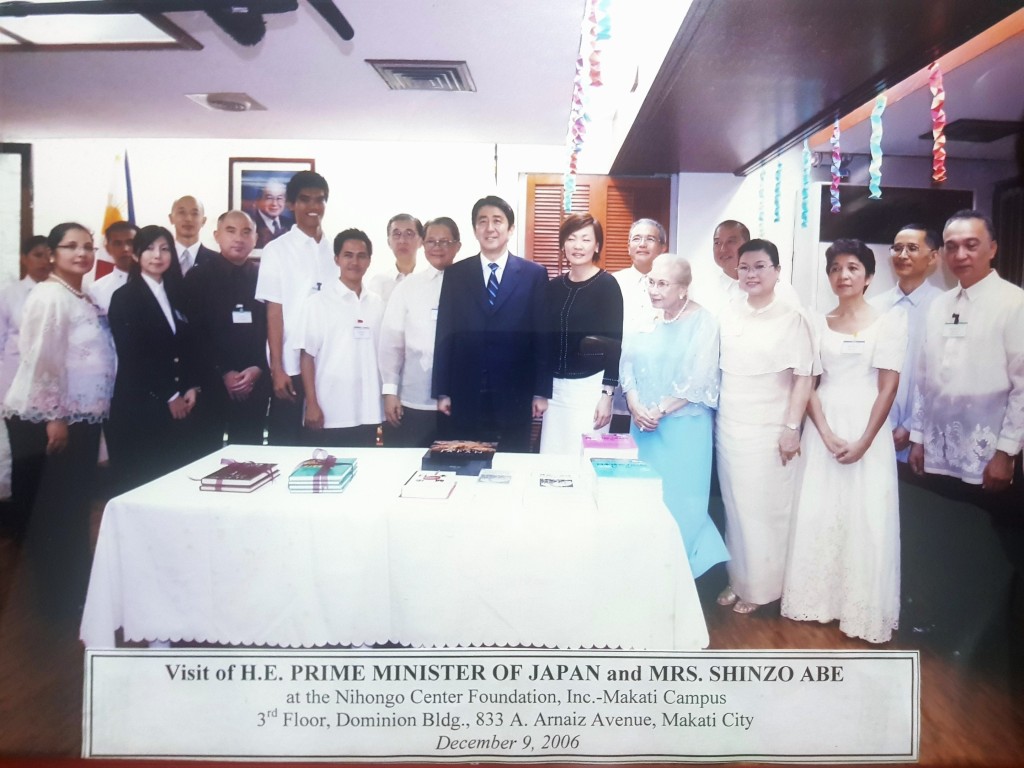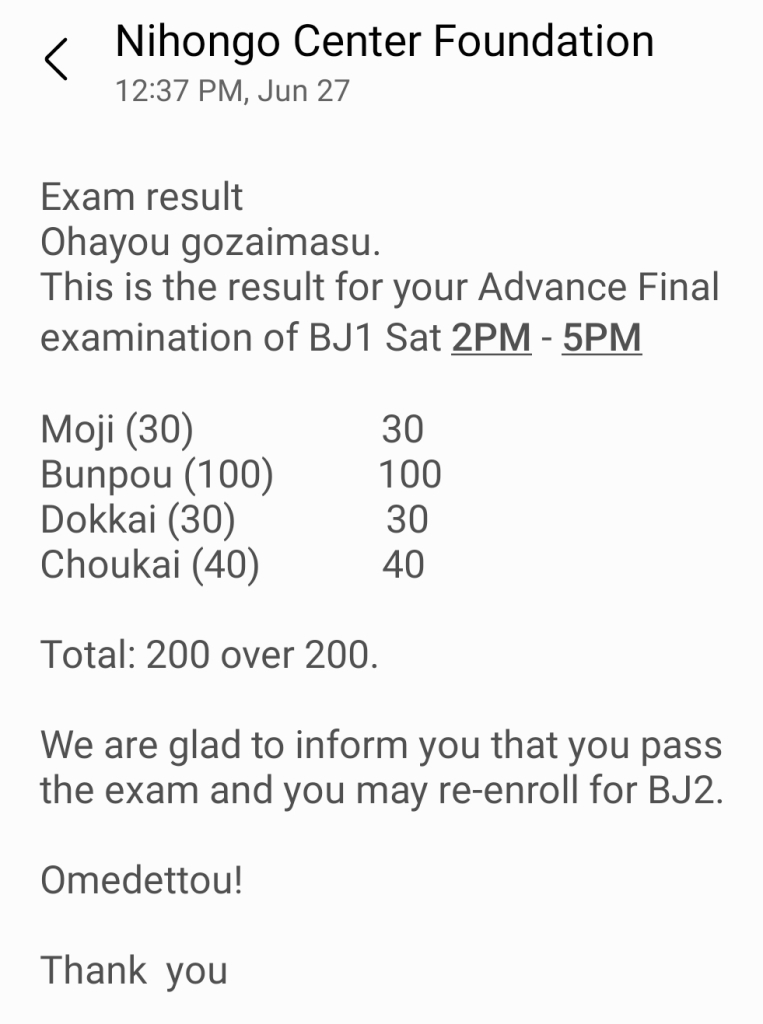In my previous article, I listed some of the best Japanese language schools in the Philippines. Among them is Nihongo Center Foundation (NCF).
I have been studying at NCF ever since I started learning Japanese in February 2018. My growth and interest in the Japanese language have been largely shaped by NCF.
If you are interested in starting your journey in Japanese at NCF, I hope this personal blog post will give you insights into the actual learning experience at a well-respected and top-notch Japanese language institute.
At NCF, I completed all five Basic and six Intermediate main courses. Now, I am pursuing Advanced special classes. Given such length, I decided to write a three-part series of articles covering each stage of my progress in Japanese: basic, intermediate, and advanced.
Finding a Japanese language school
In late 2017, I decided to learn Japanese. I have been frequently traveling to Japan for a vacation, so I knew that learning some basic Japanese will certainly help me in my future travels.
My intent to study wasn’t anything special as studying in Japan or working at a Japanese company. But I also considered the fact that I might continue learning Japanese beyond the basic level if I liked it enough, so I thought it would be best to learn at one of the best Japanese schools right from the start.
One of the schools that I came across online was NCF. At the time, its official website looked so outdated that I almost dismissed it as a non-competitive ordinary school. However, I decided to give it a chance by reading its history posted on its website. (NCF rebranded in 2020 so its page looks amazing now.)
I was impressed when I learned of NCF’s heritage and long history of helping Filipinos succeed in Japanese. They also offer different class schedules, including weekly Saturday classes that fit well with my work schedule. On top of those, its Makati branch was right across my condominium. It was a perfect choice.

Immediately, I sent an inquiry to NCF by email and soon after confirmation of the class schedule, I enrolled and paid the tuition fee. The class would begin in mid-November 2017.
However, a few days before the first day of class started, my family encountered an emergency. Given the severity and uncertainty of the situation, I decided to withdraw from that class and put my enrollment on hold. Thankfully, the administration kindly accommodated my request.
Learning the basics through classes
NCF follows a standard curriculum and materials, but how the lessons are taught in class depends on the instructor’s teaching style.
I have been fortunate to learn under the instruction of four highly skilled and passionate teachers who have been teaching Japanese for at least a decade.
Basic Japanese 1: Taking the first steps
I was placed in the Saturday afternoon class that started in February 2018. In that class, there were more than twenty students including myself.
For the first three sessions, we were taught basic greetings, how to introduce ourselves in Japanese, and how to read and write two Japanese syllabaries, hiragana and katakana.
Our teacher drilled into us hiragana and katakana through quizzes, drills, and writing practice. This was necessary for us to be able to read our textbook, Minna no Nihongo, which is written entirely in Japanese text.

From the fourth to the last session, we covered the first ten chapters of Minna no Nihongo. On top of the lessons and homework, we also did recitations and skits in class to apply our learnings. Eventually, we were introduced to kanji, and we learned our first 60 characters.
Halfway through, I began to feel the slow pace of classes since they were held only once a week. Fortunately, my schedule became much more flexible, so I could now join weekday classes.
I asked my teacher and the administrative staff if I could jump straight to Basic 2. Both advised me to take and pass the final exam to comply with the school guidelines. However, they warned me against the possibility of failure because I haven’t finished the course yet. Regardless, I decided to take the challenge, so I scheduled my final exam in mid-June of 2018.
I was on vacation abroad for most of June, so I did my studies every night at the hotel room, during long bus rides, and on both of my long-haul flights. Then, a week after my arrival in Manila, I took the final exam at NCF. With luck and effort, I passed the test.

Basic Japanese 2: Learning by doing
In July 2018, I started taking classes for Basic 2 while also attending Basic 1. (Crazy, I know.) This time, classes were held every morning of Monday, Wednesday, and Friday. While Basic 1 took an agonizing six months to finish, Basic 2 lasted for only two months with its tighter schedule.
In Basic 2, our teacher had a different teaching style: She gave more emphasis on the application of language concepts through a variety of class activities such as role-playing, practice conversations, and games. We even did Japanese calligraphy near the end of the course.

In terms of the scope of the lessons in this class, we learned how to count different objects by using counters, form longer and compound sentences, and expand our expressions through verb conjugations. I especially liked the simple trick that we were taught to learn and master the -te form of verbs.
Beyond my teacher’s hands-on approach in teaching Japanese, she has been supportive of us students. She praised those who performed well in exams and encouraged everyone to join the Japanese speech contest. Three of us in the class, including myself, eventually participated in the contest.
We were eleven in this class, and most of them continued their studies at NCF all the way to Intermediate 3. I’ve been with them only until the final basic course, but we’ve stayed connected since then. They have become long-time friends.

Basic Japanese 3: Transition to JLPT N4 level
Just a little over a week since Basic 2 concluded, we started classes for Basic 3. Most of my classmates from Basic 2 were eager to continue learning Japanese, so a schedule for us was immediately arranged.
Basic 3 serves as the bridge between N5 (lower basic) and N4 (upper basic) levels. By finishing about half of this course, you could easily pass N5 with high scores. Nevertheless, some of my new classmates already took and passed N5 in July 2018, even prior to attending Basic 3.
In this course, the lessons were a little more challenging. We were introduced to intransitive verbs and modifying clauses. Though tricky at first, they’re my favorite grammar points. To me, these are powerful and versatile grammar concepts that are useful in forming complex sentences.
Like our previous instructors, our teacher in this class incorporated role-playing and conversation activities. But she also added a lot of writing activities so that we could practice putting our ideas into words more carefully. Our teacher here had a good mix of teaching through theory and practice.

Basic Japanese 4: Moving to a new location
Though a few of my classmates did not continue to Basic 4 anymore, our number was still enough to fill in the slots for the class. This time, our schedule shifted to afternoon classes every Monday, Wednesday, and Friday starting in November 2018.
Our instructor for this class was a senior faculty member. He wasn’t the type to prepare PowerPoint presentations; he could teach effectively with just a book in his hand. He knew even the smallest nuances and details in the Japanese language–a true grammarian.
In Basic 4, we learned expressions such as those used to form conjectures, relay information, and express purpose or intent. Potential and passive forms of verbs and nominalizers (changing non-nouns into nouns) were some of the new concepts that I enjoyed the most.
We were also taught 85 new kanji, while developing a deeper appreciation of radicals (the parts that compose a kanji), thanks to our teacher’s expertise.

For most of December, there were no classes due to the holidays. When we returned in January 2019, the Makati branch of NCF has moved from its original location at Arnaiz Street (Pasay Road) to its new home along Esteban Street.
The new branch looked more modern, cleaner, and brighter. It even had a nice, well-decorated lounge for important guests. This branch now has better facilities to accommodate future NCF students.
Basic Japanese 5: The final hurdle
Two weeks after Basic 4 ended, we moved on to the next and final Basic course. All my classmates from Basic 4 joined, and a few more new students joined the class. We returned to a morning schedule as well.
Here, we had the same instructor from Basic 4. I think having him teach us for this course was a good opportunity. There were challenging new grammar concepts, such as the causative form of verbs, but thankfully, our teacher was persistent until we had a good grasp of the lesson.
On top of that, our teacher entertained all our questions about anything related to Japanese. He even stayed after class hours so that he can accommodate everybody’s queries, and he answered all of them with as much detail as he could. He even taught me a few intermediate-level grammar points, saying that they’ll prove useful to me in the future.
In class, we also had our first encounter with honorific speech, which is called keigo, as our last lesson for this course. Keigo was tough for us who were then beginners, so I am glad that we were properly guided. At the same time, we also had to learn nearly a hundred more kanji, so it was a huge step up from the previous course level.
Basic 5 ended in late March 2019. With this final course, we finished all 50 chapters of Minna no Nihongo. After a long and tiring final exam, we all went out for lunch at a nearby Japanese restaurant called Jyukai.

Results of completion
With the conclusion of Basic 5, we patiently waited for the results of our final exam. Then, the good news arrived: We all passed! So, we were now eligible to continue to Intermediate 1.
On top of that, an announcement was made for the top three students who finished Basic 5 for the entire year in both the Manila and Makati branches. My two good friends and I claimed those top rankings. As recognition of our efforts, we were granted the Amb. Jose S. Laurel III scholarship.
The scholarship covers the tuition fees for Intermediate 1, and the portion subsidized by the scholarship varies depending on the final grade in Basic 5. My final grade made me eligible for a full scholarship.

On top of this scholarship, I was consistently receiving the highest possible rebate, which is 15% of the tuition fee, for each of my Basic classes. The rebate was a really nice incentive for performing well in exams. Both the scholarship and the rebates significantly helped me fund my Japanese studies.
At this point, learning Japanese has become a fun, challenging, and memorable journey for me. It is one of the best decisions that I made in my entire life.
I joined Basic 1, just wanting to learn basic travel phrases, and then I finished Basic 5 with a stronger desire to learn and improve myself in Japanese. As such, I am thankful to NCF for cultivating my interest and passion for the Japanese language.
If you are interested to enroll at NCF, please send an inquiry through their official website using this link. You may also check the list of courses here.


I really enjoyed your post!
LikeLike